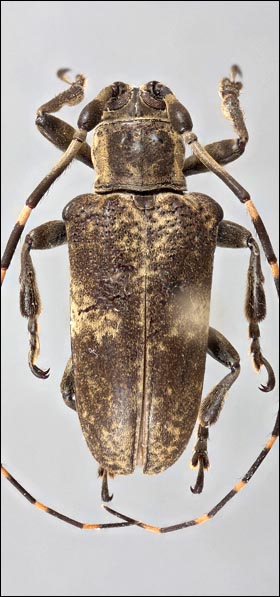 |
 Previous Genus Next Genus Previous Genus Next Genus 
Genus: Touroultia
Diagnostic Features
- Description: General form elongate-ovate, robust, small to moderate-sized, 11–17 mm in length. Head with frons elongate, about 1.5 times width of lower eye lobe. Eyes with lower lobes large, oblong. Genae distinctly shorter than lower eye lobes. Antennae distinctly longer than body; antennal tubercles prominent, moderately separated; scape robust, clavate; antennomere III longest. Pronotum subcylindrical, transverse, sides
feebly sinuate; disk with three tubercles; disk with one basal transverse sulcus, and a more distinct oblique sulcus laterally which continues down the side. Scutellum transverse, apex rounded. Elytra with lateral margins slightly sinuate, gradually rounded to apices at apical 1/3; humeri prominent. Legs moderate in length; profemora robust; meso- and metafemora clavate apically; tibiae slightly expanded apically; metafemora about 1/3 as long as elytra.
- The combination of the following characters will help to distinguish this genus: genae distinctly shorter than lower lobes, from 1/3 to 1/2 as tall; frons distinctly elongate and narrow, about as wide as width of 1 to 1.5 lower eye lobes; pronotum subcylindrical; elytra about 3.75 times longer than pronotal length.
- Similar genus/genera: the genus Touroultia resembles Priscatoides.
Geographic Distribution
- South America (Brazil, Ecuador, French Guiana)
Host Plants/Trees
Girdling Behavior
Notes
Generic Synonymies
Selected References
|
 |
 
Touroultia swifti
holotype specimen, ♂
© N.P. Lord
|
© 2011-2015 Nearns, E.H., Lord, N.P., and K.B. Miller
The University of New Mexico and Center for Plant Health Science and Technology, USDA, APHIS, PPQ.
|


